My blogging is lagging, and not because I’m gagging, or even lollygagging, just too much going on at once. My book rollout for Nowtopia was last Wednesday and I’m now in the flow of the my “tour” which leaves SF on April 28, but continues later tonight at SmackDab and next Thursday at Modern Times. You can check out the podcast of my rollout reading if you can’t join me at one of my tour stops.
Golden Gate Bridge from Twin Peaks, April 2008.
I wanted to complement my book’s appearance by noting some useful items in the media, both online and off, that help the larger anti-economy argument that Nowtopia is part of. In the current Harper’s magazine, Kevin Phillips writes about the fake numbers that underpin our sense of “economic reality”: “Numbers Racket: Why the Economy is Worse Than We Know”. He gives an overview of how government economics statistics have been jerryrigged and altered quite a few times just since the 1970s, leading to the imaginary economic health much touted by Clinton and Bush during the past 16 years. Turns out unemployment, if measured as it once was, would be closer to 9%, inflation would be running at 12% and GNP and “growth” would have been much worse than reported. Of course the important caveat here is that I don’t believe in any of these numbers either! The whole system of measuring wealth and economic activity is so skewed away from any sense of what’s meaningful or true as to be quite meaningless anyway. But Phillips, a former Nixon speechwriter and Republican strategist (and more recently, debunker of the Bush Dynasty as a criminal enterprise spanning generations) wants to reclaim economic stats from the funhouse they’ve been relegated to. One compelling stat he cites is that in order to artifically hold up the illusion of economic growth during two decades of financial chicanery, 15% of “Gross Domestic Product (GDP)” value in 2007 is accounted for by “imputed” income (the benefit one receives from a free checking account, or the imputed income of living in one’s own home, or the value of employer-paid life or health insurance premiums).
Phillips’ article follows the interesting piece “Faustian Economics: Hell Hath No Limits” by Wendell Berry, in the same issue, which is trying (again) to focus Americans on the reality of limits. Berry has been writing from a radical ecologist position for years now, and often he brings in a quasi-religious tone that really puts me off. He admits as much in this article.
“We are, in short, coming under pressure to understand ourselves as limited creatures in a limited world… I am well aware of what I risk in bringing this language of religion into what is normally a scientific discussion. I do so because I doubt that we can define our present problems adequately, let alone solve them, without some recourse to our cultural heritage.”
Much as I loathe the admonitional tone that wants to chastise for living beyond our limits, I can easily understand the basic ecological truth of that point. Berry’s article escapes his own rhetorical trap as it proceeds and by the end I was quite happy with it.
“As a consequence, our great need now is for… specifically human sciences and technologies, working, as the best humans always have worked, within self-imposed limits. The limits would be the accepted contexts of places, communities, and neighborhoods, both natural and human… if the idea of appropriate limitation seems unacceptable to use, that may be because…we confuse limits with confinement.”
I liked this because I do react to it that way, and his further elaboration was so smart, to relate this notion of limits to those accepted by, for example, an artist working within a certain canvas, or space. He also notes that perhaps we’ve forgotten that even though some things are limited, they might also be inexhaustible:
“For example, an ecosystem, even that of a working forest or farm, so long as it remains ecologically intact, is inexhaustible.”
Berry dovetails with the arguments in Nowtopia when he concludes by arguing for the artists over the scientists (though he notes that scientists CAN be seen as doing work artistically too):
“If we want to make our economic landscapes sustainably and abundantly productive, we must do so by maintaining in them a living formal complexity something like that of natural ecosystems. We can do this only by raising to the highest level or mastery of the arts of agriculture, animal husbandry, forestry, and, ultimately, the art of living.”
NOW we’re talkin’!
Here’s another beautiful shot southward from Twin Peaks towards San Bruno Mountain, blooming lupine in foreground:
On Asia Times, Martin Hutchinson takes up the story of how the last few years of financial skullduggery is slowly becoming more visible in his article The Degradation of Accounting
It is notable for example that Goldman Sachs’ Level 3 assets [meaning assets with no proven value as there is no recognized market for them] increased in the last quarter to $82.3 billion from $54.7 billion. Since it seems most unlikely that Goldman, a smart operator if ever there was one, has been deliberately loading up on $26.6 billion worth of illiquid rubbish, the change must result largely from strategic reclassification from Level 2 to Level 3. Indeed, Goldman’s Level 3 asset-backed securities doubled during the quarter to $25 billion, presumably for precisely the reason that Goldman found unattractive the market prices prevailing for those securities.
At $82.3 billion, Goldman Sachs Level 3 assets are more than twice its capital. This is not therefore a peripheral problem, which can be allowed to remain hidden within the arcana of accounting conferences. The reality is that, as was demonstrated in the true recessions of 1973-74 and 1980-82 but not in the mere dips of 1990-92 and 2001-02, the value of highly illiquid Level 3 assets taken on at the peak of a bull market is pretty well a big fat zero.
Asia Times and a lot of other websites are chock full of these kinds of analyses these days. If the unfolding credit crash continues to its logical conclusion it’s hard not to see us on our way to a global depression as catastrophic as the 1930s or perhaps worse, given the interlocked economies produced by two decades of pell-mell globalizaton. In any case, holding on to monetary or property assets as hedges against this unravelling disaster is probably a hopeless effort. What we’ll have left, really, is just ourselves and our friends and communities, and what created all this in the first place, our ability to do things.
One of the most interesting places to read some really intelligent thoughts on survival strategies that can be applied nearly anywhere is at one of my favorite blogs, John Robb’s Global Guerrillas. In the past couple of weeks he’s taken up an argument that will be in his next book on local “resilience.” With the SF Bay Guardian’s cover story this week on the problems of solar energy in San Francisco, Robb’s brief discussion of Microgrids is a useful reframing. In the context of extremely vulnerable centralized power and water and food systems, moving towards local self-reliance, and “resilient communities” is becoming a practical strategy for folks seeking simple security. Finding ways to provide the basics of the good life to each other locally, in ways that allow us to withdraw as needed from decaying and vulnerable systems that are ultimately doomed, makes sense. Not from the point of view of gated communities who are barring the have-nots from entry (which might be Robb’s natural readership, though it’s hard to say) but from the point of view of recognizing that the system ALREADY is failing large parts of the population and that will only grow worse in time. We should band together sooner rather than later to meet our basic needs collectively, needs we determine together in the context of our available skills and resources. As we become more skilled at this, we can share this kind of model far and wide, because it’s the best hope for people wherever they are, whatever their level of resources or skills. Robb even addresses local fabrication in a recent post.
This Saturday I’ll be conducting one of my periodic bicycle history tours, on the Transit theme. By coincidence I was sent review copies of two lovely books by Rebecca Schall Historic Photos of San Francisco and Historic Photos of Paris. Her San Francisco book has a lot of great images, all dug out of the San Francisco History Room in the Public Library. Here’s the cover, showcasing the “Roar of the Four” era:
And one of my favorites, not so glamorous perhaps, but compelling from an ecological history point of view, showing streetcars passing through a flood at 16th and Folsom in 1905. This intersection is very much in the floodplain and wetlands of Mission Creek, filled in since the 1860s, but once a navigable body of water.
The most recent tour before this upcoming one was on Dissent, which ended at the Anarchist Book Fair in Golden Gate Park after some reconfiguring I did with the awesome assistance of Lisa Ruth Elliott, who is helping me with Shaping San Francisco now. Here’s a shot of us in front of 250 Scott, where Kenneth Rexroth used to host his weekly salons of the Libertarian Circle back in the 1950s.
We probably won’t make our way as far west as the new murals Mona Caron is painting in Noe Valley, but in the lower right corner of the eastern one she is incorporating some very imaginative transit ideas for a future San Francisco:
And then there are some images I collected over the past few weeks that I didn’t get to post.
Antiwar protests filled downtown on the March 19 5th anniversary of the beginning of the Iraq War. I think this stencil was probably painted during that time, under the overpass at Howard near 2nd Street.
Here’s a view westbound from the same part of Howard Street, downtown on a Saturday…
Prior to that I was down on Pier 4 taking pictures back at the backlit downtown:
And on the transit theme, here’s a shot of one of the ferries that still ply bay waters, followed by an image of the Port of Oakland’s huge container cranes, technology that has permanently altered the shoreline of San Francisco by removing the loading and unloading of ships to the east bay:
This odd block of Buchanan north of Broadway plummets and an improbably steep angle, with trees growing from the cement and cobblestone covering:
And a view to the north from the top of the block:
Lastly, a shot from above my house on Bernal Heights. The long green street leaving from the near part of the bottom of the hill is Folsom Street and I live a few blocks up it from the hill…
I think I’ll be blogging more when I hit the road, but it’s hard to be sure… I’ll try!

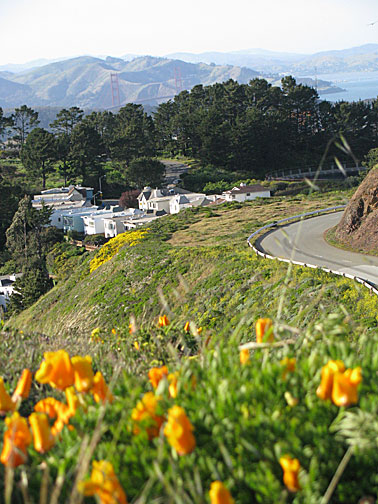
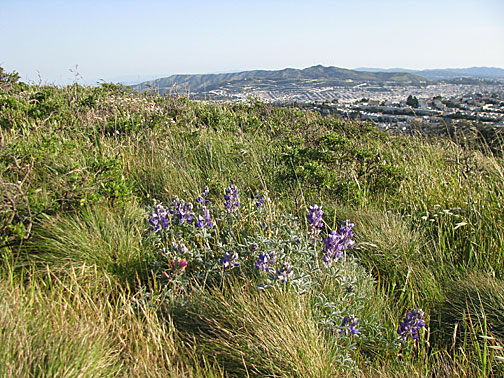
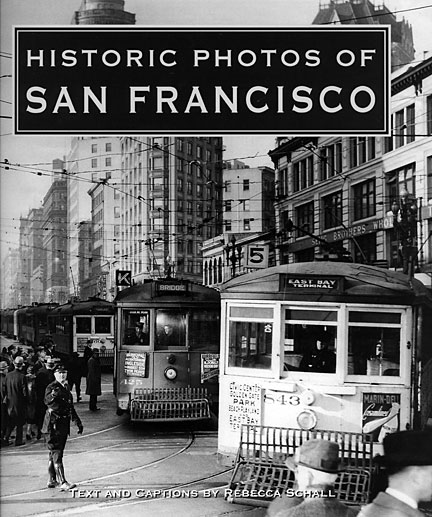
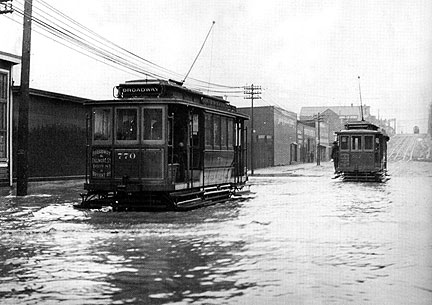
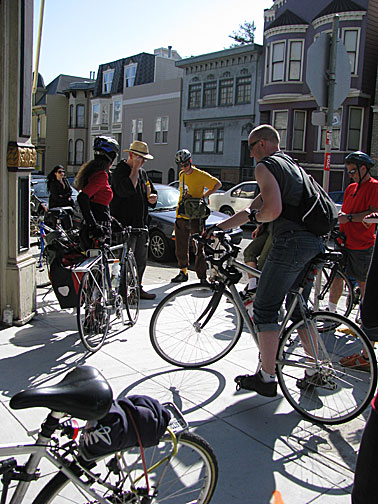
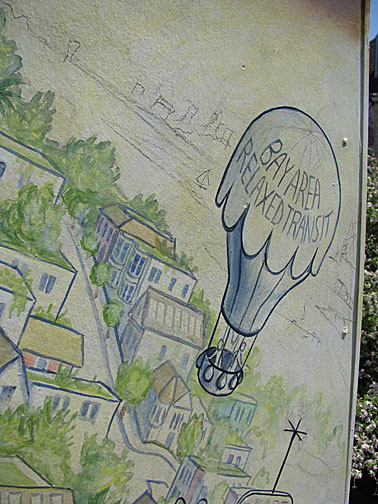
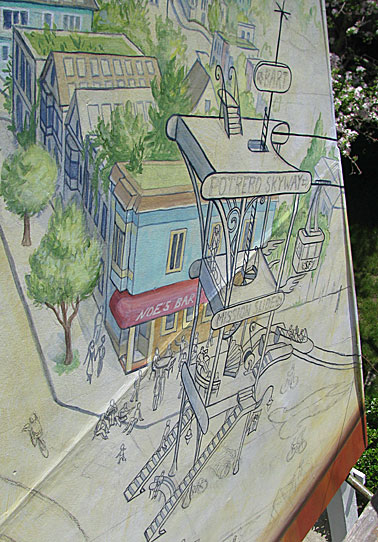
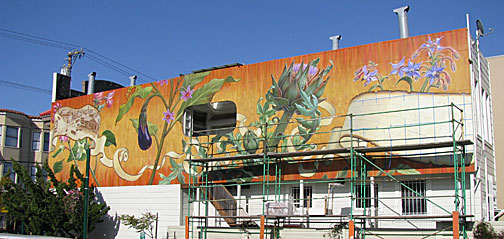
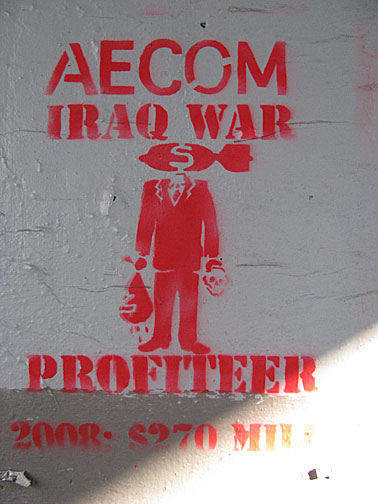
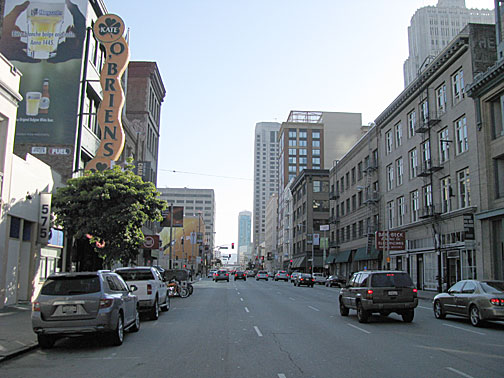
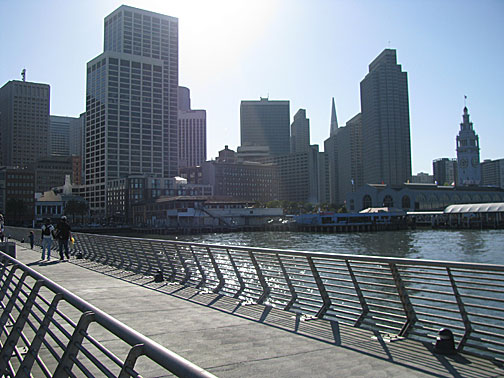
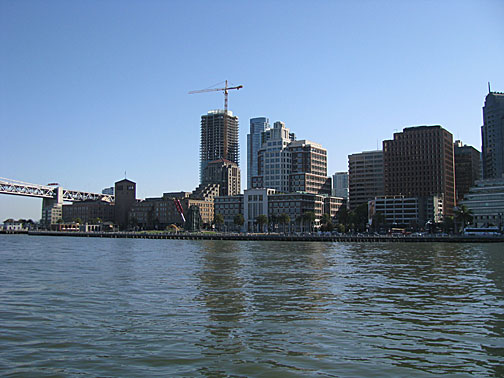
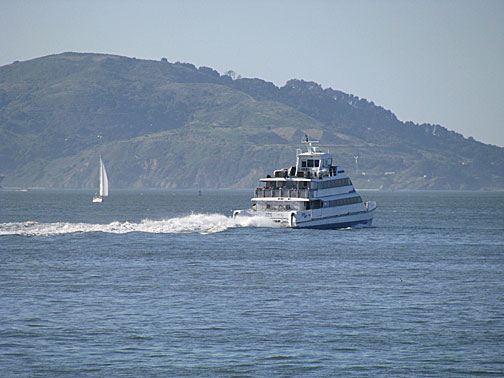
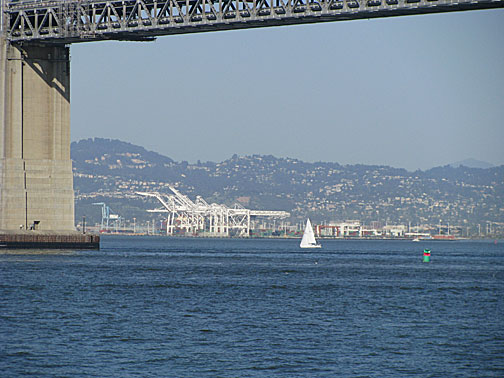
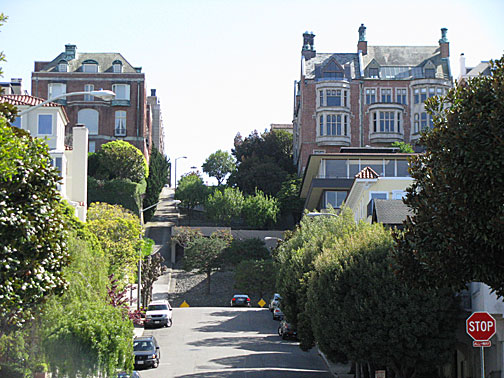
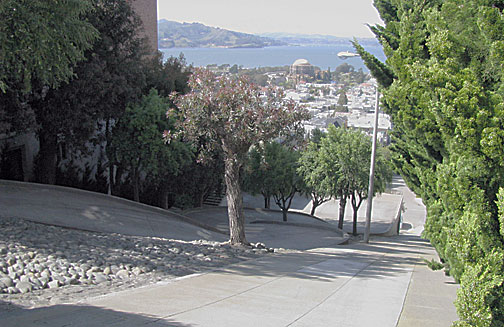
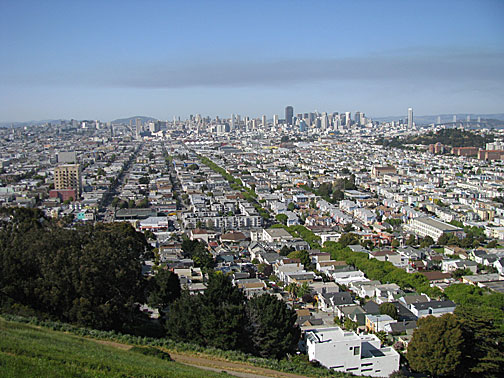











Leave a Reply